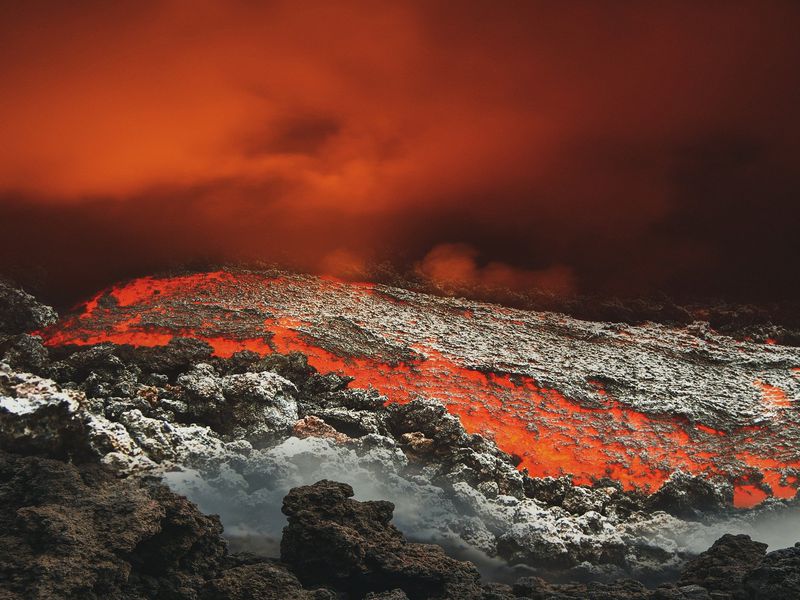4.5 billions years ago, the Earth’s early atmosphere was similar to present Venus
To celebrate the end of the year, the LabEx UnivEarthS proposes to come back to its outstanding 2020 results. First stop on this retrospective: an international team, including IPGP researchers, reveals how the Earth’s primitive atmosphere must have been extremely rich in carbon dioxide in similar proportions to what is currently found in the atmosphere of Venus.

The Earth’s current atmosphere, composed mainly of nitrogen (N2) and oxygen (O2), is very different from those of its neighbouring planets, with the atmospheres of Mars and Venus being saturated with carbon dioxide (CO2) and a small amount of nitrogen. How can this fundamental difference be explained? To do so, let’s go back in time.
About 4.5 billion years ago, our proto-Earth collided with a protoplanet the size of Mars (the Moon was born from the impact between these two objects). This collision was so important that the Earth’s original atmosphere evaporated, and the surface was covered by an ocean of magma. It is the interactions between this ocean of magma and the vapours and gases it releases that will determine the composition of the Earth’s new atmosphere. But how do we know the composition of this atmosphere? Although many models of the early atmosphere have been proposed, none of them has reached a consensus. This is due to the difficulties in reproducing the extreme conditions present on Earth in the laboratory.
However, this is the challenge that a team of researchers, including geoscientist from the IPGP, has set itself. To do this, they first recreated rocks in the laboratory whose chemical composition is identical to that of the Earth’s mantle. These model rock samples, only 2 mm in diameter, are then subjected to extreme temperatures, between 1800 and 1850 °C, in order to reproduce the conditions of the primitive Earth and its ocean of magma. This molten rock is then placed in different gas mixtures, consistent with the different atmospheres possibly present at that time.
By comparing the composition of this molten rock with natural samples of mantle rocks (in particular the oxidation state of the iron in the rocks), it is then possible to determine under which atmosphere the magma ocean on the Earth’s surface was immersed 4.5 billion years ago. The result: the Earth’s early atmosphere would have been composed mainly of carbon monoxide (CO) and carbon dioxide. Then, as the Earth cooled, the Earth’s atmosphere would have become composed of CO2-N2 at pressures and proportions similar to those observed today on the planet Venus. In other words, conditions that are far from ideal for the emergence of life.
How then can we explain the atmospheric changes that led to the Earth we know today? The answer lies in the Earth’s privileged position in the solar system and its ideal mass. These are essential properties that allowed the emergence of oceans, this time of liquid water, for very long periods. It is these oceans that absorbed a large part of the CO2 present in the Earth’s initial atmosphere, thus allowing the development of life. Conditions that are not found on Venus.
References:
Sossi, P.A., Burnham, A. D., Badro, J., Lanzirotti, A., Newville, M. & O’Neill, H.St.C. Redox state of Earth’s magma ocean and its Venus-like early atmosphere. Science Advances.
doi: 10.1126/sciadv.abd1387
The LabEx UnivEarthS contributed to this research by funding the “Multidisciplinary investigation of the deep Earth” Frontier project (F7).
- 4.5 billions years ago, the Earth’s early atmosphere was similar to present Venus [1/10]
- Observing supernovae: neutrino detectors to the rescue [2/10]
- At the origins of the Solar System, millimetre-sized crystals at the heart of certain meteorites [3/10]
- Kinetic Inductance Detectors, a promising technology for precision astronomy [4/10]
- Light-speed seismology to prevent earthquakes [5/10]
- ATHENA, a technical challenge for the new generation of X-ray telescope [6/10]
- Dune fields, a key to understanding the climate of other “Earths” in the Solar System [7/10]
- SVOM/ECLAIRs space instrument will pave the way to a deeper understanding of ultra-long gamma-ray bursts [8/10]
- InSight/SEIS probes further into the heart of Mars [9/10]
- The search for dark matter compatible with the search for supernovae [10/10]
